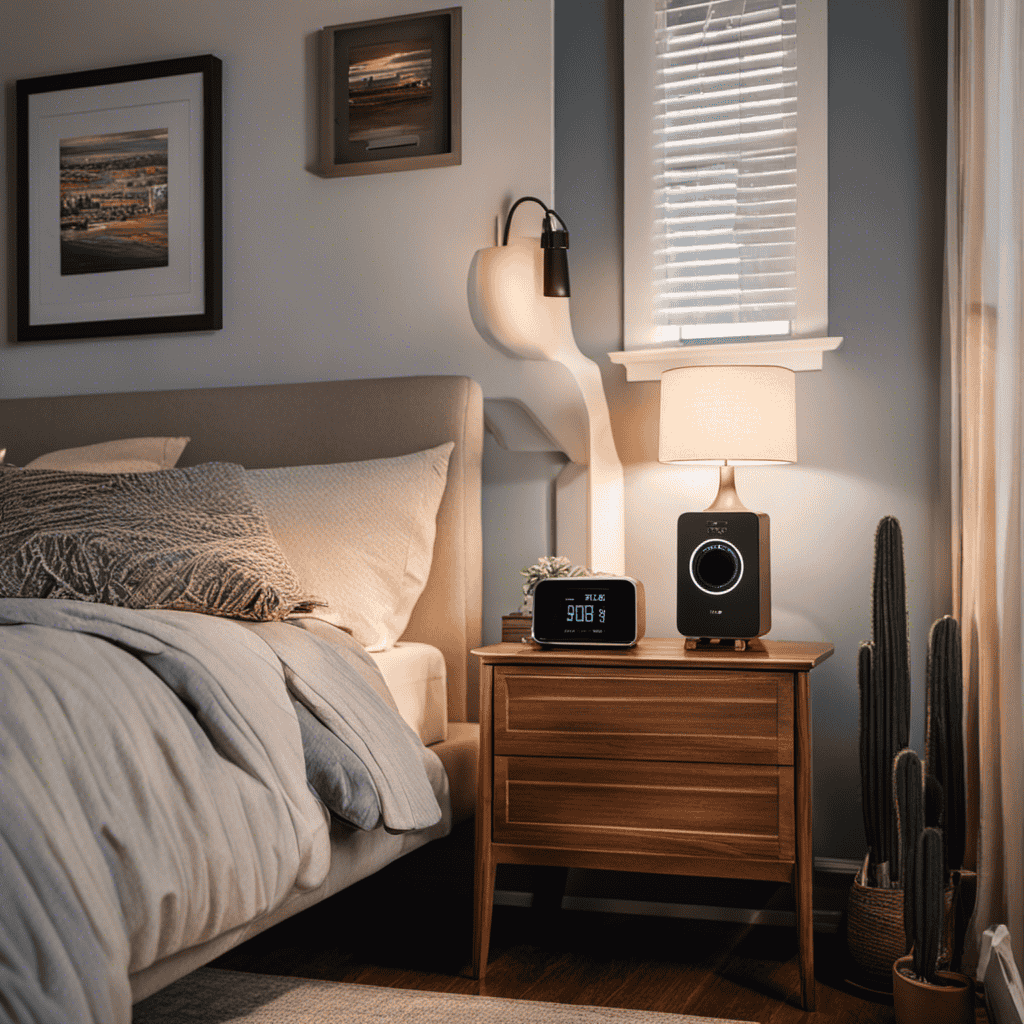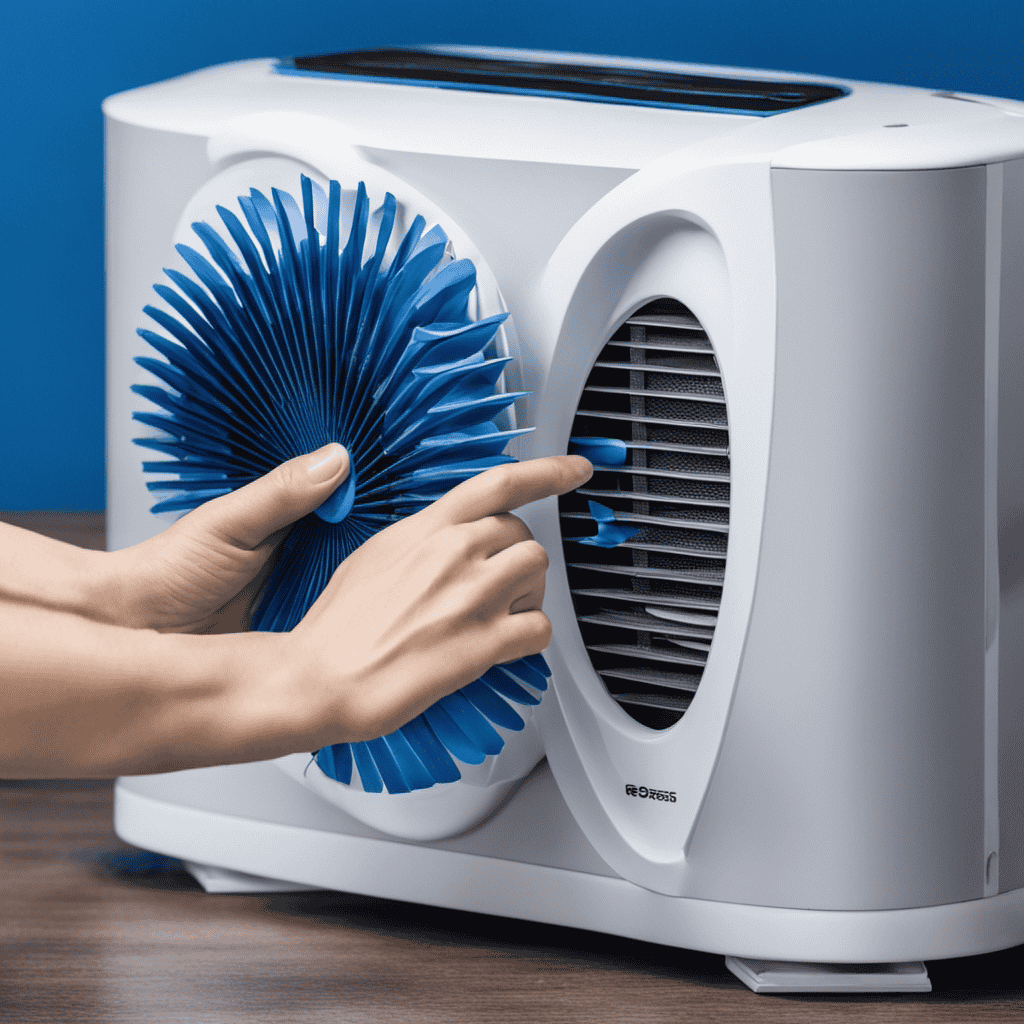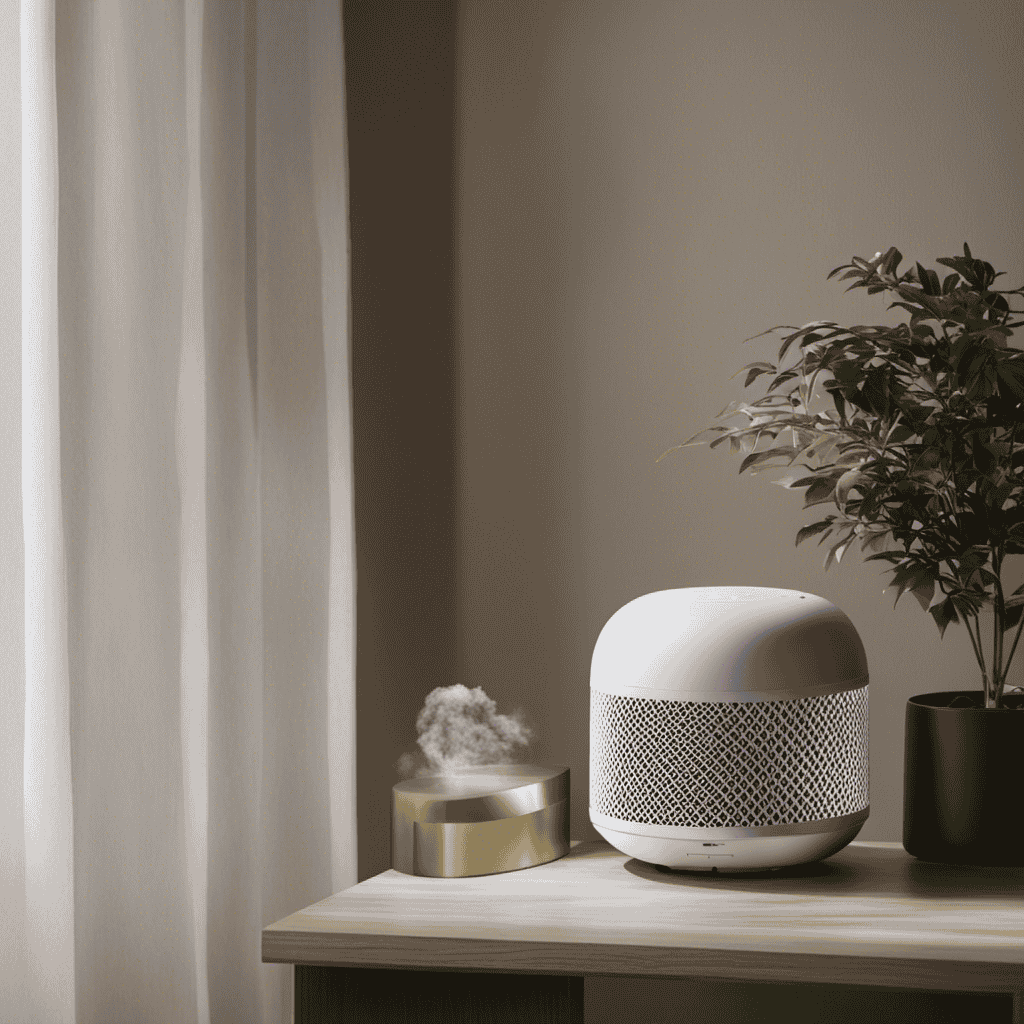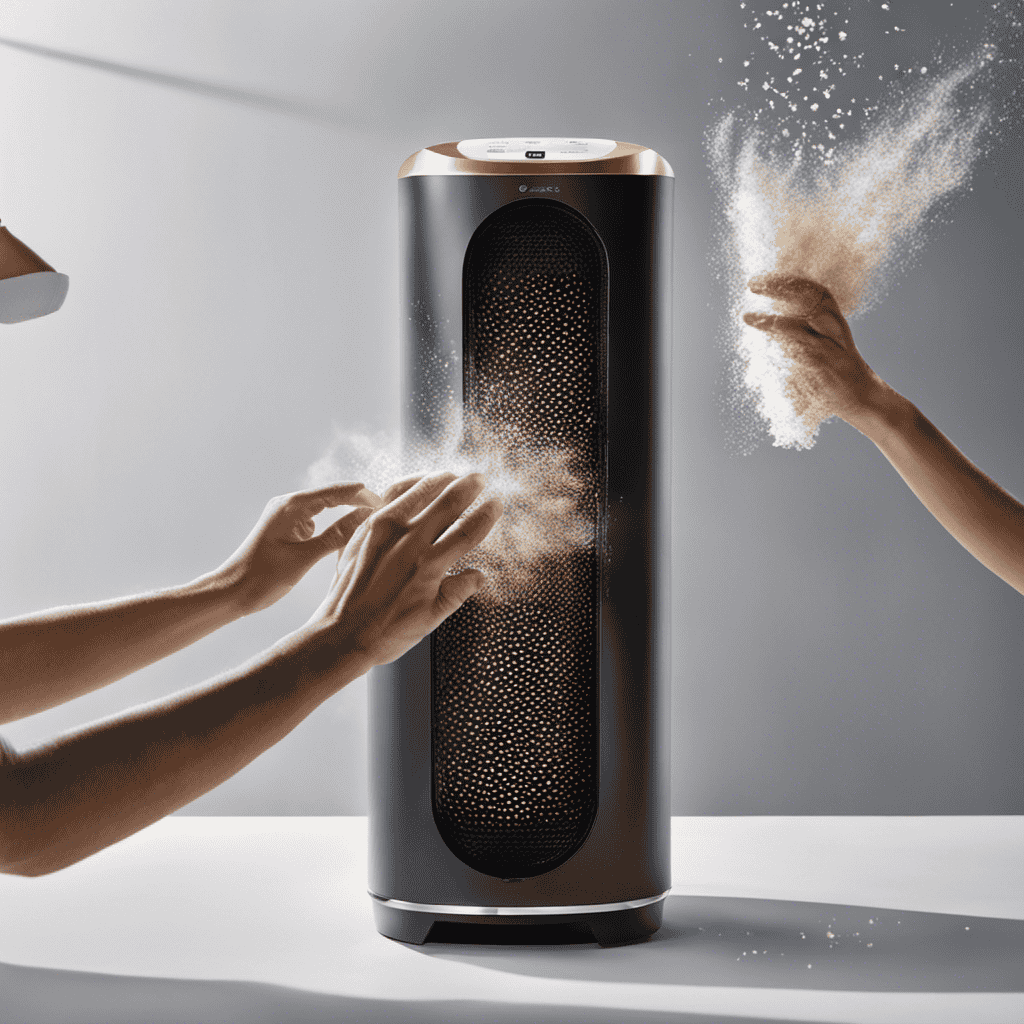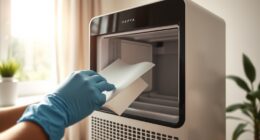In the words of the wise, ‘Knowledge is power.’ When it comes to operating a small room air purifier, knowing the cost implications can empower us to make informed decisions.
In this article, I will delve into the various factors that contribute to the overall cost of running an air purifier. From the initial investment to the ongoing energy consumption and maintenance expenses, we will explore the data and crunch the numbers to determine the true value of keeping the air in our rooms clean and fresh.
Key Takeaways
- Consider the initial investment and purchasing considerations, such as the type of air purifier, size and coverage area, maintenance requirements, and price points.
- Learn about energy-saving features in air purifiers, such as sensors that adjust fan speed and power consumption based on air quality, timers, sleep modes, and ENERGY STAR certification.
- Calculate the electricity costs and monthly expenses by determining the wattage, multiplying it by the number of hours used per day, converting the daily energy consumption to kilowatt-hours, and multiplying it by the cost per kilowatt-hour.
- Factor in the ongoing cost of filter replacement and maintenance, regularly replace filters, and consider the cost of replacement filters based on the brand and model of the air purifier.
Initial Investment: Purchasing the Air Purifier
To purchase the air purifier, you’ll need to consider the initial investment.
When it comes to purchasing options, there are a few factors to keep in mind. Firstly, you need to decide on the type of air purifier you want. There are various options available, such as HEPA filters or activated carbon filters. Each has its own benefits and price points.
Additionally, you should consider the size and coverage area of the air purifier, as larger rooms may require more powerful models. Another important aspect to consider is the maintenance requirements. Some air purifiers require regular filter replacements, which can add to the overall cost.
It’s essential to factor in these expenses when calculating the initial investment for your air purifier.
Energy Consumption: Understanding the Power Usage
Energy-saving features play a crucial role in determining the overall power usage of an air purifier and its impact on electricity bills. Understanding these features is essential for making informed decisions about energy consumption.
Energy-Saving Features Explained
You’ll be pleased to know that air purifiers with energy-saving features can help you save on electricity costs while keeping your indoor air clean.
With advancements in smart technology, manufacturers have developed energy-efficient models that optimize power usage without compromising on performance. These air purifiers are equipped with sensors that detect the air quality in real-time, adjusting the fan speed and power consumption accordingly.
They also come with timers and sleep modes that allow you to schedule when the purifier should be running, reducing unnecessary energy consumption. Additionally, some models have automatic shut-off features that turn off the device when the air quality reaches a desired level, further conserving energy.
Impact on Electricity Bills
Using an energy-efficient air purifier can significantly lower your monthly electricity bill. Energy efficient models are designed to consume less power while still providing effective air purification. When choosing an air purifier, look for models that have an ENERGY STAR certification, as they meet strict energy efficiency guidelines set by the Environmental Protection Agency.
Additionally, consider the size of the room and the air purifier’s coverage area. Using the appropriate size air purifier for your room can help reduce energy consumption. It’s also important to clean or replace the air filters regularly as clogged filters can make the air purifier work harder and use more energy.
Lastly, consider operating the air purifier on a lower fan speed setting or using the timer function to further reduce energy consumption. By following these tips, you can enjoy cleaner air while keeping your electricity bill in check.
Electricity Costs: Calculating the Monthly Energy Expenses
To calculate your monthly energy expenses for running a small room air purifier, first determine the wattage of the device. Look for this information on the product label or in the user manual. Energy efficient models usually have lower wattage, which can help save on electricity costs.
Once you have the wattage, multiply it by the number of hours you use the air purifier each day. This will give you the daily energy consumption in watt-hours. To convert this to kilowatt-hours, divide by 1000.
Finally, multiply the kilowatt-hours by the cost per kilowatt-hour from your electricity bill to find your monthly energy expenses. Remember, to further save on costs, consider using the air purifier only when necessary and keep it on a lower fan speed setting.
Transitioning to the next section, after calculating your energy expenses, it’s important to budget for regular maintenance, such as filter replacement.
Filter Replacement: Budgeting for Regular Maintenance
In order to properly budget for regular maintenance of a small room air purifier, it is important to consider the cost of filter replacement. Filters play a crucial role in removing pollutants from the air, but they have a limited lifespan.
Here are three key points to keep in mind when it comes to filter replacement:
-
Maintenance cost: Filter replacement is an ongoing expense that should be factored into your overall budget. The cost of replacement filters can vary depending on the brand and model of your air purifier.
-
Filter lifespan: The lifespan of a filter typically depends on several factors, such as the quality of the filter and the amount of pollutants it is exposed to. It is important to check the manufacturer’s guidelines to determine how often the filter needs to be replaced.
-
Regular maintenance: Regularly replacing the filter is essential to ensure the optimal performance of your air purifier. Neglecting filter replacement can lead to reduced air quality and increased energy consumption.
Additional Costs: Assessing Other Expenses
When assessing other expenses, it’s important to factor in the costs of maintenance and replacement parts. While the upfront cost of a small room air purifier may seem reasonable, there are hidden expenses that need to be considered.
Regular maintenance is crucial for optimal performance and longevity of the purifier. This includes cleaning the filters, which may need to be replaced periodically. The cost of replacement filters can vary depending on the brand and model of the air purifier.
Additionally, there may be other hidden expenses such as electricity usage and any additional features or accessories that need to be purchased separately.
It is essential to assess these maintenance and hidden expenses when calculating the overall cost of running a small room air purifier.
Cost Comparison: Evaluating the Overall Value
When it comes to evaluating the overall value of a product, two key factors to consider are price versus performance and long-term cost analysis.
Price versus performance examines whether the product’s price aligns with its performance capabilities, ensuring that you are getting the most bang for your buck.
On the other hand, long-term cost analysis delves into the ongoing expenses associated with the product, such as maintenance, energy consumption, and replacement parts, to determine its true cost over time.
Price Vs. Performance
Comparing the price and performance of small room air purifiers can help you make an informed decision. When considering the price range, it is important to assess the overall value of the purifier in relation to its performance. Here are three key factors to consider when comparing the price and performance of small room air purifiers:
-
CADR (Clean Air Delivery Rate): This metric measures the purifier’s ability to remove airborne pollutants. Look for a higher CADR rating, as it indicates better performance in cleaning the air.
-
Energy Efficiency: Consider the purifier’s energy consumption and operating costs. Look for ENERGY STAR certified models that are designed to be energy-efficient, helping you save on electricity bills in the long run.
-
Filter Replacement Costs: Check the price and frequency of filter replacements. Some purifiers may have cheaper upfront costs but require expensive filter replacements, significantly increasing the overall cost of ownership.
Long-Term Cost Analysis
To determine the overall value of the purifier, consider how often you will need to replace the filters and the associated expenses.
When analyzing the long-term cost of an air purifier, it is important to factor in the lifespan of the device and the cost of replacing filters. On average, the lifespan of an air purifier ranges from 5 to 10 years. However, this can vary depending on the brand and model.
Additionally, the frequency of filter replacements can vary depending on the air quality in your environment and the specific requirements of the purifier. To extend the lifespan of your filters and reduce costs, consider implementing cost-saving tips such as regularly cleaning and maintaining the purifier, using a pre-filter, and purchasing filters in bulk or opting for washable filters.
Frequently Asked Questions
How Often Do I Need to Replace the Filters in a Small Room Air Purifier?
When should I replace the filters in a small room air purifier? How can I clean the filters? It is recommended to replace the filters every 3-6 months, depending on usage. Clean them regularly to ensure optimal performance.
Are There Any Additional Costs Associated With Running a Small Room Air Purifier?
There are additional maintenance and long term expenses associated with running a small room air purifier. These include the cost of replacing filters, electricity usage, and potential repairs or parts replacement.
Can I Use a Small Room Air Purifier in Multiple Rooms, or Do I Need One for Each Room?
I can use a small room air purifier in multiple rooms, but it’s more efficient to have one for each room. Efficiency is key when it comes to air purification.
Do Air Purifiers Have Any Impact on My Heating or Cooling Costs?
Air purifiers do not have a significant impact on heating or cooling costs. However, they can improve heating and cooling efficiency by reducing the need for excessive ventilation. Additionally, air purifiers have a positive environmental impact by removing pollutants from the air.
Are There Any Energy-Efficient Models Available for Small Room Air Purifiers?
When it comes to energy-efficient models for small room air purifiers, there are plenty of options available. These models not only reduce energy consumption, but also provide long-term savings on your utility bills.
Conclusion
In conclusion, running a small room air purifier involves several costs that need to be considered.
The initial investment in purchasing the air purifier can range from $100 to $500, depending on the brand and features.
Energy consumption is an important factor to consider, with air purifiers typically consuming around 50-200 watts of power. This leads to an average monthly electricity cost of $5-$20, based on the local electricity rates.
Regular filter replacements should be budgeted for, with filters costing around $20-$100 per year.
Overall, the cost of running a small room air purifier varies depending on individual factors, but it is essential to consider these expenses to assess the overall value and benefits it provides.
Interestingly, studies have shown that using an air purifier can reduce indoor air pollution by up to 99%. This statistic highlights the significant impact an air purifier can have on improving the air quality in our homes.
